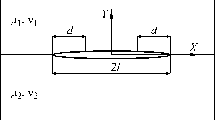Abstract
A model of fracturing of an interface between dissimilar materials in the presence of a section of weakened bonds between materials is considered. Such a section is modeled by a crack, between the faces of which adhesion forces act, depending on the crack opening. The size of the interaction zone of the crack faces (bridged zone) can change during the crack growth and is not small compared to the crack size. To analyze the quasi-static growth of a crack with an bridged zone filled with bonds, a nonlocal fracture criterion is used, taking into account the work on deformation of the bonds in the bridged zone of the crack. The state of limiting equilibrium of the crack tip corresponds to the energy condition of the equality of the rate of deformation energy release at the crack tip and the rate of deformation energy consumption by bonds in the bridged zone of the crack (the first fracture condition). The breaking of bonds at the trailing edge of the bridged zone is determined by the condition of their limiting stretching (the second fracture condition). Proceeding from these two conditions, the modes of subcritical and quasi-static crack growth are considered and two main parameters of fracture are determined, that is, the critical external load and the size of the tip region of the crack in the state of ultimate equilibrium.
Similar content being viewed by others
REFERENCES
G. I. Barenblatt, “The formation of equilibrium cracks during brittle fracture. General ideas and hypotheses. Axially-symmetric cracks,” J. Appl. Math. Mech. 23 (3) 622–636 (1959); “Equilibrium cracks formed during brittle fracture rectilinear cracks in plane plates,” 23 (4) 1009–1029 (1959); “Concerning equilibrium cracks forming during brittle fracture. The stability of isolated cracks. Relationships with energetic theories,” 23 (5), 1273–1282 (1959).
M. Ya. Leonov and V. V. Panasyuk, “Development of slight cracks in a solid body,” Prikl. Mekh. 5 (4), 391–401 (1959).
D. S. Dugdale, “Yielding of steel sheets containing slits,” J. Mech. Phys. Solids 8 (2), 100–104 (1960).
M. Elices, G. V. Guinea, J.Gomez, and J. Planas, “The cohesive zone model: advantages, limitations and challenges,” Eng. Fract. Mech. 69 (2), 137–163 (2002).
A. Hillerborg, M. Modeer, and P. -E. Petersson, “Analysis of crack formation and crack growth in concrete by means of fracture mechanics and finite elements,” Cem. Concr. Res. 6 (6), 773–781 (1976).
H. Stang, J. F. Olesen, P. N. Poulsen, and L. Dick-Nielsen, “On the application of cohesive crack modeling in cementitious materials,” Mater. Struct. 40 (4), 365–374 (2007).
B. N. Cox and D. B. Marshall, “Concepts for bridged cracks in fracture and fatigue,” Acta Metall. Mater. 42 (2), 341–363 (1994).
R. O. Ritchie, “Mechanisms of fatigue-crack propagation in ductile and brittle solids,” Int. J. Fract. 100 (1), 55–83 (1999).
B. F. Sorensen, E. K. Gamstedt, R. C. Ostergaard, and S. Goutianos, “Micromechanical model of cross-over fibre bridging - prediction of mixed mode bridging laws,” Mech. Mater. 40 (4–5), 220–234 (2008).
J. A. Nairn, “Analytical and numerical modeling of R curves for cracks with bridging zones,” Int. J. Fract. 155, 167–181 (2009).
R.V. Goldstein and M. N. Perelmuter, “Modeling of fracture toughness of composite materials,” Vych. Mekh. Sploshn. Sred 2 (2), 22–39 (2009).
Y. Shao, H. P. Zhao, X. Q. Feng, and H. Gao, “Discontinuous crack-bridging model for fracture toughness analysis of nacre,” J. Mech. Phys. Solids 60 (8), 1400–1419 (2012).
R.V. Goldstein and M.N. Perelmuter, “Kinetics of crack formation and growth on the material interface,” Mech. Solids 47 (4), 400–414 (2012).
C. H. Wang, “Fatigue crack closure analysis of bridged cracks representing composite repairs,” Fatigue Fract. Eng. Mater. Struct. 23 (6), 477–488 (2000).
M. N. Perelmuter, “Modeling of the self-healing kinetics of cracks,” Fiz. Mezomekh. 22 (4), 47–55 (2019).
R. Goldstein and M. Perelmuter, “Modeling of bonding at an interface crack,” Int. J. Fract. 99 (1–2), 53–79 (1999).
R. V. Goldstein and M. N. Perelmuter, “An interface crack with bonds between the surfaces,” Mech. Solids 36 (1), 77–92 (2001).
V. M. Entov and R. L. Salganik, “On the Prandtl brittle fracture model,” Izv. Akad. Nauk SSSR. Mekh. Tverd. Tela, No. 6, 87–99 (1968).
V.V. Novozhilov, “On a necessary and sufficient criterion for brittle strength,” J. Appl. Math. Mech. 33 (2), 201–210 (1969).
L. R. F. Rose, “Crack reinforcement by distributed springs,” J. Mech. Phys. Solids 35 (4), 383–405 (1987).
J. R. Rice and G. C. Sih, “Plane problems of cracks in dissimilar media,” J. Appl. Mech. 32 (2), 418–423 (1965).
V.V. Novozhilov, “On the foundations of a theory of equilibrium cracks in elastic solids,” J. Appl. Math. Mech. 33 (5), 777–790 (1969).
M.A. Grekov and N.F. Morozov, “Equilibrium cracks in composites reinforced with unidirectional fibres,” J. Appl. Math. Mech. 70 (6), 945–955 (2006).
M. N. Perelmuter, “A criterion for the growth of cracks with bonds in the end zone,” J. Appl. Math. Mech. 71 (1), 137–153 (2007).
P. Cornetti, N. Pugno, A. Carpinteri, and D. Taylor, “Finite fracture mechanics: a coupled stress and energy failure criterion,” Eng. Fract. Mech. 73 (14), 2021–2033 (2006).
G. P. Cherepanov, Mechanics of Brittle Fracture (McGraw-Hill, New York, 1979).
R. L. Salganik, “The brittle fracture of cemented bodies,” J. Appl. Math. Mech. 27 (5), 1468–1478 (1963).
M. Perelmuter, “Nonlocal criterion of bridged cracks growth: weak interface,” J. Eur. Ceram. Soc. 34 (11), 2789–2798 (2014).
M. Perelmuter, “Nonlocal criterion of bridged cracks growth: analytical analysis,” Acta Mech. 226 (2), 397–418 (2015).
Funding
This work was carried out with the financial support of the Russian Science Foundation (project No. 19-19-00616).
Author information
Authors and Affiliations
Corresponding author
Additional information
Translated by I. K. Katuev
About this article
Cite this article
Perelmuter, M.N. Analysis of Crack Resistance of Interfaces between Materials. Mech. Solids 55, 536–551 (2020). https://doi.org/10.3103/S0025654420040123
Received:
Revised:
Accepted:
Published:
Issue Date:
DOI: https://doi.org/10.3103/S0025654420040123




